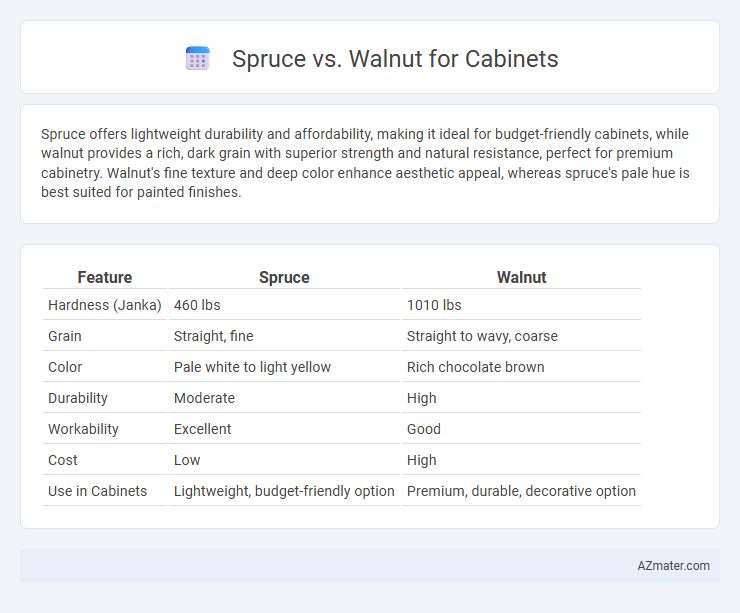Spruce offers lightweight durability and affordability, making it ideal for budget-friendly cabinets, while walnut provides a rich, dark grain with superior strength and natural resistance, perfect for premium cabinetry. Walnut's fine texture and deep color enhance aesthetic appeal, whereas spruce's pale hue is best suited for painted finishes.
Table of Comparison
| Feature | Spruce | Walnut |
|---|---|---|
| Hardness (Janka) | 460 lbs | 1010 lbs |
| Grain | Straight, fine | Straight to wavy, coarse |
| Color | Pale white to light yellow | Rich chocolate brown |
| Durability | Moderate | High |
| Workability | Excellent | Good |
| Cost | Low | High |
| Use in Cabinets | Lightweight, budget-friendly option | Premium, durable, decorative option |
Introduction to Spruce and Walnut for Cabinets
Spruce wood features a light, creamy color with a straight grain, making it a popular choice for cabinets that emphasize a clean, modern aesthetic. Walnut offers rich, dark brown tones with a complex grain pattern, providing a luxurious and sophisticated look for cabinetry. Both woods vary in hardness and durability, with walnut generally being harder and more resistant to wear, suitable for high-traffic kitchen environments.
Appearance and Grain Patterns
Spruce cabinets feature a light, pale color with subtle, fine grain patterns that create a clean and minimalist aesthetic ideal for modern or Scandinavian-style interiors. Walnut offers rich, deep brown tones with intricate, pronounced grain patterns that add luxurious warmth and sophistication, making it suitable for traditional or high-end designs. The distinct contrast between spruce's uniformity and walnut's varied texture allows homeowners to choose based on the desired visual impact and interior style.
Durability and Hardness Comparison
Walnut is significantly harder and more durable than Spruce, with a Janka hardness rating of about 1,010 lbf compared to Spruce's 420 lbf, making Walnut better suited for high-traffic or heavy-use cabinetry. Spruce, being softer and less dense, is more prone to dents and scratches, which limits its durability in comparison to Walnut. Walnut's superior hardness and dimensional stability provide longer-lasting performance and resistance to wear in cabinetry applications.
Workability and Ease of Finishing
Spruce cabinets offer excellent workability due to their softness and straight grain, making them easy to cut, shape, and sand with minimal effort. Walnut, while denser and harder, provides a smooth finish that enhances durability but requires sharper tools and more skill during the finishing process to avoid blotching. Both woods accept stains and finishes well, but spruce is more forgiving for beginners, whereas walnut delivers a richer, more luxurious appearance when finished properly.
Cost Differences Between Spruce and Walnut
Spruce cabinets are significantly more affordable than walnut due to spruce's faster growth rate and wider availability, resulting in lower material costs. Walnut's rich color, durability, and fine grain make it a premium hardwood, contributing to its higher price point, often two to three times more expensive than spruce. Choosing spruce offers budget-friendly cabinetry without sacrificing strength, while walnut provides a luxurious, high-end finish that justifies the increased investment.
Weight and Density Considerations
Spruce, with a density of approximately 400 kg/m3, is significantly lighter than walnut, which has a density around 660 kg/m3, impacting cabinet weight and structural support requirements. The lighter weight of spruce makes it easier to handle and suitable for wall-mounted cabinets, while walnut's higher density offers greater durability and resistance to dents. Choosing between spruce and walnut for cabinets depends on balancing the need for lightweight materials against the desire for a more robust, premium finish.
Stability and Resistance to Warping
Walnut offers superior stability and resistance to warping compared to spruce due to its dense hardwood properties, making it ideal for long-lasting cabinetry in varying humidity conditions. Spruce, being a softwood, is more prone to expansion and contraction, which can lead to warping over time, especially in humid or fluctuating environments. For cabinetry requiring durability and consistent shape retention, walnut is the preferred choice.
Environmental Impact and Sustainability
Spruce cabinets offer superior environmental benefits due to their rapid growth rate and high carbon sequestration, making them a more sustainable choice compared to walnut. Walnut trees grow slower and are often harvested from less renewable sources, increasing their ecological footprint. Choosing spruce supports sustainable forestry practices and reduces the carbon impact of cabinet production.
Best Applications for Spruce vs. Walnut Cabinets
Spruce cabinets are ideal for budget-friendly, lightweight applications such as kitchen cabinets and storage units where ease of installation and a light, natural aesthetic are priorities. Walnut cabinets excel in luxury environments, offering exceptional durability and rich, dark tones perfect for high-end kitchens, office furniture, and statement cabinetry. The contrasting grain patterns and hardness levels make spruce suitable for painted finishes, while walnut is best showcased with clear finishes to highlight its natural beauty.
Choosing the Right Wood for Your Cabinet Project
Spruce offers a lightweight, affordable option with a pale, consistent grain that suits modern, minimalist cabinet designs. Walnut provides a rich, dark color and durability, making it ideal for high-end cabinetry with a luxurious, classic appeal. Selecting the right wood depends on budget, desired aesthetic, and cabinet use, with spruce favored for cost-effectiveness and walnut prized for elegance and longevity.

Infographic: Spruce vs Walnut for Cabinet
 azmater.com
azmater.com